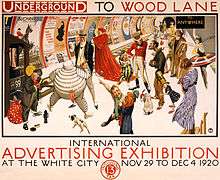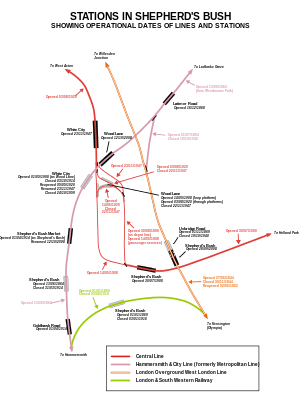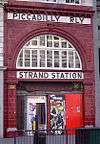Wood Lane tube station (Metropolitan line)
Wood Lane was a station on the London Underground that was located in Shepherd's Bush, west London. It was opened in 1908 on the Hammersmith branch of the Metropolitan Railway (now the Hammersmith & City line), on the viaduct adjacent to the bridge over Wood Lane and close to a station of the same name but on the Central London Railway (now the Central line).
| Wood Lane | |
|---|---|
 Wood Lane Location of Wood Lane in Greater London | |
| Location | Shepherd's Bush |
| Local authority | Hammersmith & Fulham |
| Owner | Metropolitan Railway |
| Number of platforms | 2 |
| Key dates | |
| 1 May 1908 | Opened as Wood Lane (Exhibition) |
| 31 October 1914 | Closed |
| 5 November 1920 | Reopened on ad hoc basis as Wood Lane (White City) |
| 23 November 1947 | Renamed White City |
| 24 October 1959 | Closed |
| Replaced by | Wood Lane |
| Other information | |
| WGS84 | |
It was closed temporarily in 1914, reopened in 1920 and eventually closed permanently in 1959 at which time it was served by the Metropolitan line.
History
Exhibition station
The two Wood Lane stations were opened in 1908 to serve the Franco-British Exhibition and the 1908 Olympic Games in the area that was to become known as White City. The Metropolitan Railway's Wood Lane opened with the name Wood Lane (Exhibition) on 1 May 1908 and the Central London Railway's Wood Lane station opened on 14 May 1908. Both were intended to be temporary and to be closed after the exhibition and the Games. Wood Lane (Exhibition) station was closed on 31 October 1914, shortly after the outbreak of the First World War. The other Wood Lane became the permanent western terminus of the Central London Railway.

Reopening
The station was brought back into use on 5 November 1920,[1] with the name Wood Lane (White City), but was open only when an exhibition or event was being staged.
It was served by the Metropolitan line and was between Shepherd's Bush and Latimer Road.
Final renaming and subsequent closure
The Central line's Wood Lane closed, and was replaced by White City station situated just to the north, on 23 November 1947. The Metropolitan line station changed its name to White City on the same date. It retained this name for the remainder of its existence.
Following a fire in which one of the wooden platforms was destroyed, the Metropolitan line White City station was permanently closed on 24 October 1959, and the Television Centre complex now runs on both sides of the railway. The station at viaduct level was largely demolished; the ticket office at ground level remains and has been repainted, though is not visible from the street.
The entrance from Wood Lane (and a main entrance to the exhibitions) was situated along a road which no longer exists that ran approximately along the line of the entrance to the Television Centre multi-storey car park. The centre point of the platforms was approximately opposite the largest of the BBC satellite dishes to the west of the line.

As part of the plans for the redevelopment of White City, a new Wood Lane station was built on the Hammersmith & City line. Opened on 12 October 2008, it is on the east side of Wood Lane about 100 metres (330 ft) north-east of the former Metropolitan line station.
Latimer Road & Acton Railway
The Latimer Road & Acton Railway (LR&AR), a nominally independent company, proposed a line linking the Hammersmith & City Railway at Wood Lane with the Great Western Railway east of their Acton station. The H&CR initially insisted that the LR&AR built a separate exchange station at Wood Lane, rather than using the existing platforms. The GWR wanted the LR&AR to also build a separate Acton station, and a house was demolished at Friar's Place for this.[2][3]
The railway was authorised by act in 1882, but between 1885 and 1893 four acts for extensions of time were needed, as the LR&A Company could not reach agreement with the Great Western and the Metropolitan for joint-working of the line. When this was finally achieved (confirmed by act in 1895), capital could not be raised. The line was abandoned by act in 1900, after only small parts had been built, including an iron bridge (later demolished) over the North & South Western Junction Railway near the current Westway road bridge. The later Ealing & Shepherd's Bush Railway followed a similar route to the proposed LR&AR line,[3] the Metropolitan ironically promoting a bill in 1912 to connect the Hammersmith & City to this line, which failed on opposition from the Great Western, the Central London Railway, and the District Railway.[2]
References
- London's Disused Underground Stations by J.E.Connor page 60
- Jackson, Alan (1978). London's Local Railways (1st ed.). Newton Abbot: David & Charles. pp. 370–372. ISBN 0-7153-7479-6.
- Jackson, Alan (1986). London's Metropolitan Railway. Newton Abbot: David & Charles. p. 375. ISBN 0-7153-8839-8.
- Rose, Douglas (1999). The London Underground: a Diagrammatic History (7th ed.). Capital Transport Publishing. ISBN 1-85414-219-4.
External links
- London Transport Museum Photographic Archive. Wood Lane station, circa 1910
| Disused railways | ||||
|---|---|---|---|---|
| Preceding station | Following station | |||
| Shepherd's Bush towards Hammersmith |
Metropolitan line Hammersmith branch (1920-1959) |
Latimer Road towards Barking | ||
